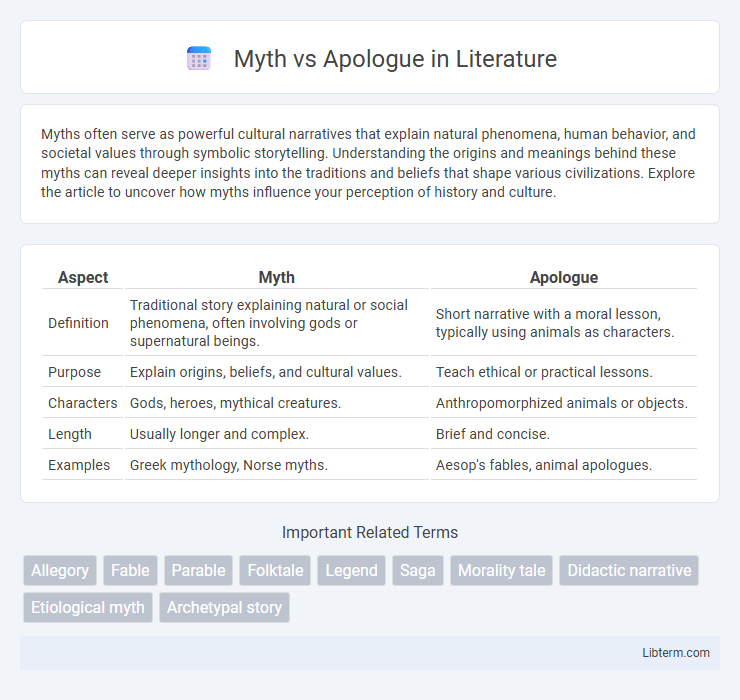Myths often serve as powerful cultural narratives that explain natural phenomena, human behavior, and societal values through symbolic storytelling. Understanding the origins and meanings behind these myths can reveal deeper insights into the traditions and beliefs that shape various civilizations. Explore the article to uncover how myths influence your perception of history and culture.
Table of Comparison
| Aspect | Myth | Apologue |
|---|---|---|
| Definition | Traditional story explaining natural or social phenomena, often involving gods or supernatural beings. | Short narrative with a moral lesson, typically using animals as characters. |
| Purpose | Explain origins, beliefs, and cultural values. | Teach ethical or practical lessons. |
| Characters | Gods, heroes, mythical creatures. | Anthropomorphized animals or objects. |
| Length | Usually longer and complex. | Brief and concise. |
| Examples | Greek mythology, Norse myths. | Aesop's fables, animal apologues. |
Understanding the Concepts: Myth and Apologue
Myths are traditional narratives rooted in ancient cultures often explaining natural phenomena or human behavior through gods and supernatural elements. Apologues, in contrast, are short allegorical stories designed to impart moral lessons using animals or inanimate objects as characters. Understanding these concepts highlights myths as foundational cultural tales, whereas apologues serve as concise ethical guides.
Origins and Historical Contexts
Myths originate from ancient civilizations, serving as sacred narratives that explain natural phenomena, deities, and cultural traditions, often rooted in religious beliefs. Apologues, emerging prominently during the Enlightenment and Classical periods, function as moral stories using allegory and anthropomorphism to impart ethical lessons rather than cosmological explanations. The historical context of myths reflects their role in shaping societal values and worldviews, while apologues were crafted to instruct and entertain within evolving philosophical frameworks.
Key Characteristics of Myths
Myths are traditional narratives that explain natural phenomena, origins, and cultural beliefs through symbolic storytelling involving gods, heroes, and supernatural events. These stories often embody moral lessons and universal truths, rooted in the collective unconscious of a culture. Myths serve to establish societal norms, cosmological explanations, and the relationship between humans and the divine, distinguishing them from apologues which primarily focus on moral lessons through simple allegories.
Defining Features of Apologues
Apologues are short, didactic narratives featuring animals or inanimate objects as characters that convey moral lessons through allegory and symbolism. Unlike myths, which often explain natural phenomena or origins of the world, apologues emphasize clear ethical teachings and practical wisdom. Their defining features include simplicity in plot, use of personification, and a direct moral conclusion to guide behavior.
Purpose and Function in Society
Myths serve to explain natural phenomena and cultural origins through sacred narratives, reinforcing societal values and collective identity. Apologues function primarily as moral stories or fables, delivering ethical lessons through allegory to guide individual behavior. Both forms shape cultural norms, but myths emphasize cosmology and tradition, while apologues focus on practical wisdom and ethical conduct.
Major Themes Explored
Myths primarily explore universal themes such as creation, the supernatural, and the human origin, often reflecting cultural beliefs and explaining natural phenomena through gods and cosmic events. Apologues emphasize moral lessons and ethical conduct, utilizing allegory and personified characters to teach practical wisdom and virtues. Both forms deal with human experience but differ in thematic focus--myths delve into existential meaning, while apologues stress didactic ethical guidance.
Narrative Structure and Style Differences
Myths typically feature grand narratives with archetypal characters and supernatural beings, employing a formal, elevated style to convey sacred truths or cosmological origins. Apologues use concise, straightforward storytelling with anthropomorphized animals or inanimate objects to deliver clear moral lessons, often utilizing simple, accessible language. The narrative structure of myths tends to be expansive and complex, while apologues are brief and focused on illustrating specific ethical principles.
Examples of Prominent Myths
Prominent myths such as the Greek tale of Hercules showcase heroic feats symbolizing human struggle and divine intervention, while the Norse myth of Ragnarok depicts the apocalyptic end of the world and rebirth. The Egyptian myth of Osiris focuses on themes of death, resurrection, and eternal life, reflecting ancient beliefs about the afterlife. These myths serve as foundational narratives that explain natural phenomena, cultural values, and existential questions.
Famous Apologues Through Time
Famous apologues, such as Aesop's fables, use allegorical storytelling to impart moral lessons through animals and human characters, distinguishing them from myths that often explain natural phenomena or cultural origins. The Panchatantra, an ancient Indian collection of apologues, remains influential for its wise teachings through engaging tales about animals and kings. These enduring stories prioritize ethical guidance and practical wisdom, highlighting the apologue's role in moral education across cultures and centuries.
Modern Relevance and Adaptations
Modern relevance of myths lies in their ability to convey universal truths and cultural values through symbolic narratives, while apologues offer moral lessons using allegorical stories often featuring animals. Contemporary adaptations blend these forms in literature, film, and digital media to address current social issues, making ancient wisdom accessible and relatable. The enduring appeal of myths and apologues reflects their role in shaping ethical frameworks and collective identity in a rapidly evolving world.
Myth Infographic

 libterm.com
libterm.com